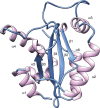Determining crystal structures through crowdsourcing and coursework
- PMID: 27633552
- PMCID: PMC5028414
- DOI: 10.1038/ncomms12549
Determining crystal structures through crowdsourcing and coursework
Erratum in
-
Corrigendum: Determining crystal structures through crowdsourcing and coursework.Nat Commun. 2016 Oct 25;7:13392. doi: 10.1038/ncomms13392. Nat Commun. 2016. PMID: 27779204 Free PMC article. No abstract available.
Abstract
We show here that computer game players can build high-quality crystal structures. Introduction of a new feature into the computer game Foldit allows players to build and real-space refine structures into electron density maps. To assess the usefulness of this feature, we held a crystallographic model-building competition between trained crystallographers, undergraduate students, Foldit players and automatic model-building algorithms. After removal of disordered residues, a team of Foldit players achieved the most accurate structure. Analysing the target protein of the competition, YPL067C, uncovered a new family of histidine triad proteins apparently involved in the prevention of amyloid toxicity. From this study, we conclude that crystallographers can utilize crowdsourcing to interpret electron density information and to produce structure solutions of the highest quality.
Figures




References
-
- Sheldrick G. M. A short history of SHELX. Acta Crystallogr. A 64, 112–122 (2008). - PubMed
-
- Touw W. G., Joosten R. P. & Vriend G. New biological insights from better structure models. J Mol Biol 428, 1375–1393 (2016). - PubMed
-
- Horowitz S., Koldewey P. & Bardwell J. C. Undergraduates improve upon published crystal structure in class assignment. Biochem. Mol. Biol. Educ. 42, 398–404 (2014). - PubMed
Publication types
MeSH terms
Substances
Grants and funding
LinkOut - more resources
Full Text Sources
Other Literature Sources
Molecular Biology Databases

